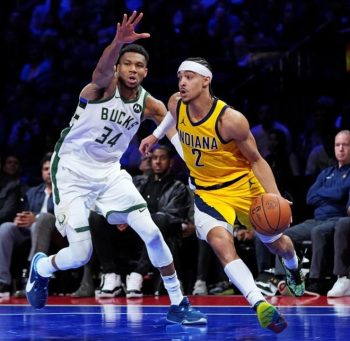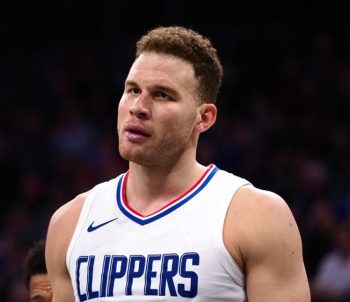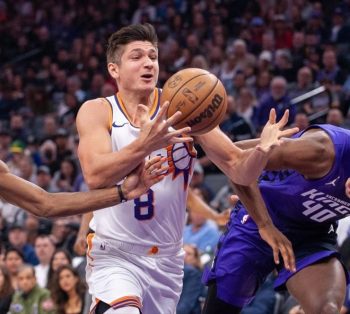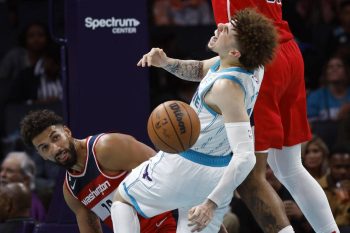NBA
Leap Year: The Utah Jazz’s Charge at Contention

Within the NBA and sports around the world, development is very rarely linear. Players aren’t flowers in soil, expected to grow and thrive at generally incremental rates so long as they’re tended to properly; the unpredictability and raw number of variables involved in the process make it far more complex. Most guys improve or decline at exponential rates, especially at the beginning and end of typical career arcs. Forecasting when, why and how much these changes will kick in is among the toughest tasks out there for league decision-makers.
The same reality exists for teams – particularly developing teams on the rise. Everyone in this position wants to emulate the Oklahoma City Thunder, whose bottom-up rebuild went so well that they neatly jumped from awful to bad to good to great in what may as well have been a hopscotch line – but it’s almost never this simple. Roadblocks are common somewhere along the line. Teams often reach a ceiling they simply can’t bust through.
Many falter even before this point, but it’s that last big leap – the one where a group goes from up-and-coming to true contenders – that’s frequently the toughest to make. A couple solid young pieces are usually enough to get a team out of the cellar within a year or two, and with any luck they’ll even be enough to form a competent core that’s competitive nightly. That next step, though, requires more: Further youth development that isn’t always realistic, cohesiveness among guys that isn’t always present, and even the successful integration of veteran talent to complement and augment things.
The Utah Jazz stand at this critical juncture in their team trajectory entering the 2016-17 season.
Utah got “awful” out of the way during a 25-win season back in 2013-14, which eventually netted them Dante Exum and Rodney Hood in the subsequent draft. They appeared ready to skip a step the following year when they added 13 wins and established themselves as a defensive force. Injuries and bits of stagnation brought them back to earth last season, the first in which the group collectively realized the challenges of leaping to that next tier. True to form, the man at the helm these last couple years takes the practical approach – and a non-basketball sports metaphor, golf in this case – when discussing last season’s roadblock.
“Obviously just mathematically, you get to a point where incremental gains [are tougher],” Jazz head coach Quin Snyder said at the team’s Media Day. “It’s harder to take your handicap from scratch to negative-one than it is from 19 to 18. So there’s going to be early gains, and I think the main thing is that our players remain consistent in their approach. However fast that pushes us in the direction we want to go, it’s hard to say. I think we’re aware of the challenges of continued improvement, and we don’t want to set a ceiling on ourselves.”
That consistency in habits is one of Snyder’s most well-worn battle cries, and something he’s thoroughly ingrained in his group over the last two years. Do things the right way, even when the talent is still missing, and it’s simple muscle memory to keep it going once the collective skill level rises. It’s a top-down philosophy in Utah.
“There’s fundamental pillars behind improvement,” Jazz general manager Dennis Lindsey said. “The glass ceilings get thicker as you get better, but the characteristics of what you have to do to improve, many times, remain the same outside of changing personnel. That’s working hard, having a humble nature, the group coming together and giving of itself. Certainly we’re built defensively, so can we move from 12th two years ago to seventh [last year] to something that’s more unique? Can we sustain that? We had that stretch in 2015 that was quite unique, and everybody’s written about it, and appropriately so – can you do that over multiple seasons? Time will tell.”
Lindsey is playing the long game as always, but there’s a more immediate aspect to expected growth this year. Expectations are a real thing even for the most process-oriented franchises, and they’ve loudly arrived in Salt Lake City among a passionate fan base.
Lindsey’s summer shows he’s well aware: George Hill, Joe Johnson and Boris Diaw are all obvious win-now acquisitions that generally run contrary to the team’s approach the last couple offseasons. The message to incumbent players is clear, and has been received.
“In the past couple years, [we’ve been] kind of experiencing things for the first time,” team captain Gordon Hayward said. “Trying to win basketball games for the first time, being in these situations we’ve never been in. So to have these guys come in and have done it before and have been successful at it, it’s going to be huge for our team.”
The acquisitions are in Utah in part to mentor youth. But make no mistake, they’re also a developmental incentive right away. Exum will start the year behind Hill after a lost season to an ACL tear, and the knowledge that Hill is fully capable of playing a heavy minute load should he lag behind should be pretty fantastic motivation for the young Aussie. Trey Lyles may begin the season ahead of Diaw in the rotation, but he’ll know a more-than-capable replacement is available if he slacks. Johnson offers similar insurance for Rodney Hood, Alec Burks and even Hayward.
The summer moves aren’t the only motivational tactic being used behind the scenes in Utah, either. The Jazz under Lindsey have been cognizant of the analytics sphere, particularly surrounding their youth and developmental trajectories, and they’ve found ways to leverage the league’s increasing reliance on big data on the practice floor.
“Certainly we want to be mindful of analytics and age graphs and improvement graphs – frankly we use those at times to challenge our players,” Lindsey said. “‘Hey, this is how your career arc is looking. This is what you’re going to have to do to break through.’ We challenged Gordon Hayward, for example, to be like Steve Nash and have a mid-to-late-20s improvement… It’s been very consistent, and we expect him to be a better player.”
With the veterans in tow, incumbents on the grind and both Exum and Alec Burks set to return to the full-time rotation, depth and how to manage it become vital elements of Utah’s desired leap. Snyder readily admitted there’d be a feeling out process with his rotations, an expected outcome given all the new pieces and his own propensity for tinkering. The Jazz went from one of the thinnest benches in the league to perhaps the most robust in just a couple short months, and an optimal outcome would see the entire group find enough collective chemistry to allow Snyder to mix and match to his heart’s extent.
There are other potential benefits to depth as well, namely health and on-court freshness. The Jazz were besieged by injuries last year, and a much deeper bench kills two related birds with one stone: More talent to plug holes if guys do happen to go down, but also enough to limit overall workloads on the top guys and help lower the risk of injury in the first place.
The Jazz can run at least 10 players deep, probably more like 11 or 12 when everyone is healthy, and so many are quality two-way pieces who typically aren’t limited by circumstances or matchups. Snyder even took things a step further at the team’s first practice, indicating he planned to emphasize a quicker offensive tempo to really leverage his depth (among other potential benefits). A faster pace means more possessions in a given game, and a 12-deep squad is better prepared to handle a more rigorous 48 minutes than teams who only run eight- or nine-man rotations.
When discussing the Jazz and potential jumps, though, note one important fact: A team leap is entirely possible even if no individual leap is visible by our traditional forms of evaluation. For those missing the rub here, let a smarter man explain it:
“Let’s just take Rodney [Hood] for example,” Lindsey said. “He could be a better player, but we have more depth, so therefore he has to do less. That’s a good thing. And I think that’s a legitimate thing. Could we increase Rodney’s usage, and have him be an 18- to 20-point a game scorer? Yeah, that’s within the possibility, if those teams going forward need those points. I’m not sure his usage will go up a whole lot, just because of the nature of the team. But it has nothing to do with his individual growth.”
There’s only one ball, and the Jazz have a lot more talented hands available to touch it than the last couple years. Hood should improve in his third NBA season, but will he really improve so much that he deserves an even further increase in touches with so many other good options now alongside him? It’s certainly possible, both for him or a couple other young guys on the roster, but probably not likely.
Through that lens, a big leap in a volume statistic like points per game for a player like Hood could actually be a decidedly negative outcome; it could easily be a lower-efficiency move necessitated by failings elsewhere on the roster. On the flip side, Hood could become a much better player and help the team make real strides without making waves on his stat sheet.
That sort of potential organic improvement will require individual sacrifice, and that’s what makes Lindsey’s approach to team-building – and Snyder’s last couple years hammering home a collective concept – so worthwhile.
“I’ve been on different teams – some teams that won a lot of games during the season and some teams that have not,” Diaw said in his first Jazz press conference. “And you see that culture is something that’s being built, but once it’s there, it’s something you can sustain at a high level. I wouldn’t say very easily, but the toughest part is to build it up. Once you get that culture, it’s easier.”
Interested betting on the Utah team? – Don’t miss out on reading our guide about sports betting in Utah first!
The guys in this locker room believe they already have that culture, and they’re ready to do what’s necessary for the greater good. The Jazz are more prepared than ever for the challenges of making their biggest leap yet.











